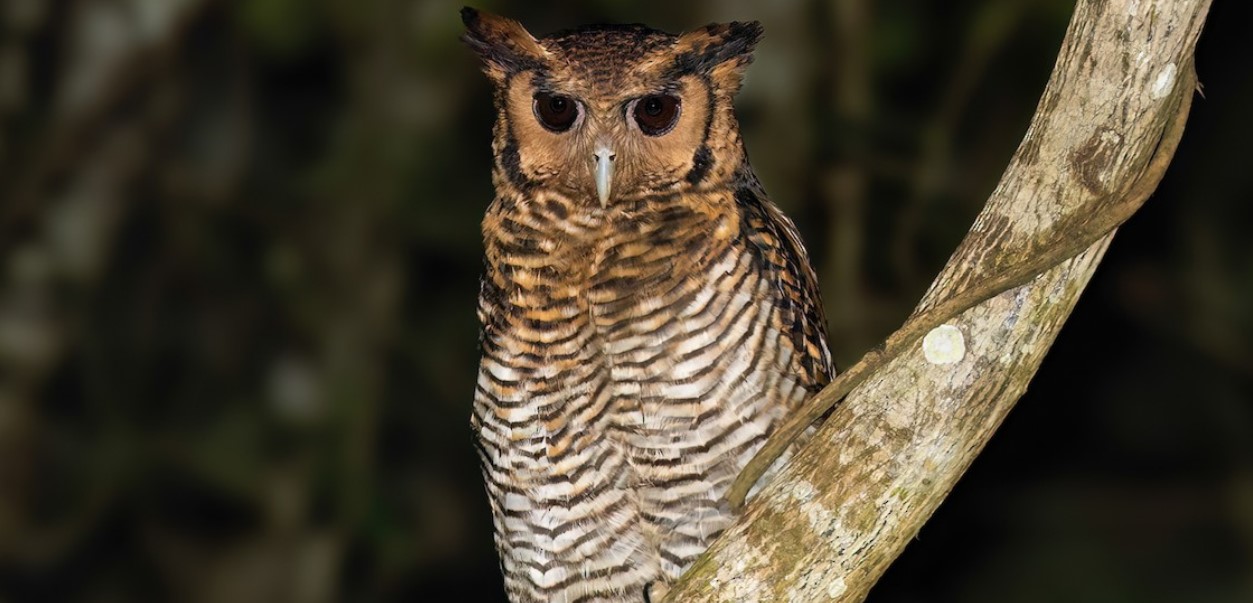
Exploring Fraser’s Eagle-Owl in Uganda
Exploring Fraser’s Eagle-Owl in Uganda: It is important to highlight Fraser’s Eagle-Owl (Bubo poensis) while talking about Uganda’s rich and varied birding environment. This huge owl, one of the most intriguing raptors in Uganda’s geographically and ecologically diverse regions, is a symbol of the country’s ecosystem’s complexity and beauty. Exploring the taxonomy, habitat, behavioural traits, conservation status, and significance of continued preservation efforts is essential to gaining a complete understanding of the Fraser’s Eagle-Owl.
Taxonomy and Distinctive Features of the Fraser’s Eagle-Owl in Uganda
Fraser’s Eagle-Owl belongs to the Strigidae family, which includes the majority of owl species also known as genuine owls. This owl, which has a wingspan of up to 1.4 meters and a length of 45 to 60 centimetres, is distinguished by its intimidating size. Large, rounded ear tufts, which have no auditory purpose but may be used for communication or to signal elevated emotions, are among its most noticeable characteristics.
The Fraser’s Eagle-Owl has primarily brown plumage with rufous and buff markings in complex designs. The owl can blend in well with its forest surroundings thanks to its colouration, which serves as an effective camouflage. As a skilled nocturnal hunter, it can identify food even in the weak light of dawn and twilight thanks to its bright yellow eyes, which are framed by a distinctive facial disc.
Habitat and Distribution when exploring Fraser’s Eagle-Owl in Uganda
Uganda is one of the primary habitats of the Fraser’s Eagle-Owl, which is mostly found in the montane and semi-deciduous forests of Central Africa. Its primary habitats inside the nation are areas with thick vegetation and a multilayered structure, which offer plenty of chances for hunting, breeding, and roosting. The Bwindi Impenetrable National Park and Semuliki National Park are notable locations for Fraser’s Eagle-Owl sightings.
The Fraser’s Eagle-Owl’s food is based on a wide variety of prey species, such as different mammals, birds, and reptiles, which are supported by the rich environment in these places. The owl benefits from the presence of fruiting trees and a variety of flora, which also draws other animals and creates an enhanced food web that supports the area’s biodiversity.
Behavioural Characteristics
The Fraser’s Eagle-Owl, a primarily nocturnal species, has modified its hunting techniques to benefit from the cover that the night offers. It uses a sit-and-wait strategy, staying hidden while watching possible prey thanks to its superior camouflage. It quickly descends to seize its prey with powerful talons after spotting a target. The owl’s broad diet, which includes small mammals, birds, and occasionally insects, reflects its opportunistic character.
A key component of the Fraser’s Eagle-Owl’s social behaviour is vocalisation. To establish territory and attract mates, it uses deep, resonant sounds that reverberate across the forests at night. The fact that they usually hoot during the breeding season emphasises how crucial auditory communication is for establishing pair bonds and demarcating their territory.
Conservation Status and Challenges of the Fraser’s Eagle-Owl in Uganda
Despite its adaptability, the Fraser’s Eagle-Owl faces several challenges that threaten its survival. Habitat destruction due to deforestation, agricultural expansion, and urbanisation has led to significant habitat loss, severely impacting its population. Additionally, the illegal pet trade poses an additional threat, as these majestic birds are sometimes captured for their exotic allure.
Currently, the International Union for Conservation of Nature (IUCN) classifies the Fraser’s Eagle-Owl as a species of “Least Concern.” However, ongoing monitoring and targeted conservation strategies are necessary to ensure that this status does not deteriorate in the face of emerging threats. Conservation organisations are increasingly focusing on habitat protection and community-based initiatives to promote the importance of preserving the natural ecosystems that support the Fraser’s Eagle-Owl.
Importance of Preservation Efforts of Fraser’s Eagle-Owl in Uganda
Beyond its fundamental significance as a species, the Fraser’s Eagle-Owl is also an indicator of the general health of the habitats in which it lives, making its protection important. By preserving this owl and its habitat, we can help maintain ecological balance and save innumerable other species. To preserve the integrity of its ecological speciality, the owl also plays a significant role in managing prey populations.
There is an increasing effort among environmentalists, eco-tourists, and local people to increase awareness of the Fraser’s Eagle-Owl’s contribution to the ecosystem. A sense of stewardship is fostered among residents by initiatives that support sustainable land-use practices, motivating them to safeguard the natural resources that support their livelihoods and cultural heritage.
The Fraser’s Eagle-Owl is a species that is representative of Uganda’s diverse fauna. Its remarkable look, intriguing behaviours, and ecological significance highlight the need for preventative conservation efforts. As Uganda keeps making investments to preserve its biodiversity, the Fraser’s Eagle-Owl serves as a reminder of the fragility and beauty of bird life in one of Africa’s most fascinating and diverse countries. In addition to protecting a unique species, our efforts to preserve this majestic owl will strengthen the resilience of the ecosystems that its existence and numerous other species depend on.
What are the best places for exploring Fraser’s Eagle-Owl in Uganda?
The two best places to see Fraser’s Eagle-Owl in Uganda are Bwindi Impenetrable National Park and Semuliki National Park. This species is distinguished by its impressive size and distinctive plumage. This secretive owl, which is frequently best seen after dusk when it is most active, has a rich habitat in Bwindi, which is well-known for its deep forest and varied bird species. Similar to this, Semuliki National Park provides ideal conditions for Fraser’s Eagle-Owl viewing due to its distinctive lowland rainforest ecology, especially along the park’s vast network of trails. In addition to increasing the possibility of seeing this magnificent bird, both parks greatly contribute to Uganda’s status as a top birding destination.
